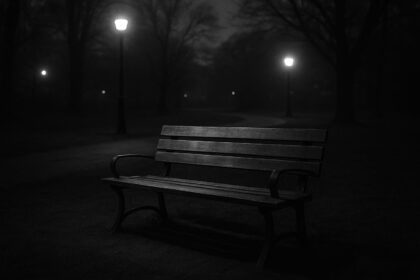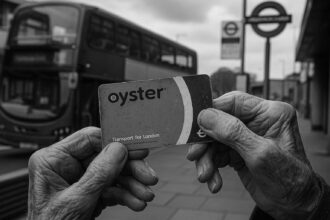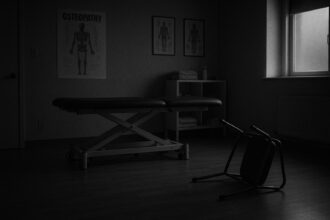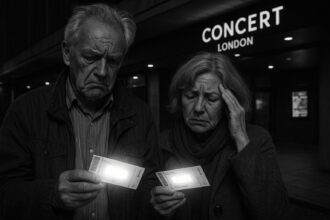Residents in Notting Hill are transforming their beautifully coloured Victorian homes into black façades, aiming to deter Instagram influencers and restore peace amid rising tensions over tourism and privacy.
In a striking response to the influx of social media enthusiasts, residents of Notting Hill have taken the unusual step of painting their houses black to deter what they describe as “rude” tourists. This eye-catching move comes amid escalating frustrations with the steady stream of visitors who flock to the area, particularly around Lancaster Road, a picturesque yet congested enclave known for its vibrant Victorian terraced houses. The move underscores the ongoing tension between local communities and the demands of social media culture, especially in a neighbourhood synonymous with bohemian charm but increasingly plagued by disturbances.
The shift to black façades is not only a bold aesthetic statement but also a strategic effort to reclaim some peace from the constant chatter of influencers and tourists. Previously adorned in bright colours, including bubblegum pink, the fronts of certain houses have been transformed to minimise their Instagram appeal. In a letter circulated among neighbours, residents have urged others to join in this darker trend, arguing that the colourful façades essentially serve as backgrounds, enticing visitors to congregate for photos. This sentiment reflects a growing desire among many locals to protect their privacy and restore tranquillity in their own homes, indicating a significant shift in the neighbourhood’s social dynamics.
The rise of “Insta-tourists” has not gone unnoticed—locals report multiple groups conducting photoshoots simultaneously, often leading to chaos. One resident noted the unsettling frequency of these gatherings over the past six months, resulting in litter, noise, and an invasion of personal space. Concerns have been echoed across various media outlets; for example, one property owner found that influencers caused over £2,000 worth of damage to his home. High heels used during shoots cracked the doorstep and damaged railings, showcasing how social media trends can have tangible effects on residential properties.
Interestingly, estate agents are observing a broader trend away from traditional pastel colours towards more minimalist black exteriors in Notting Hill. This development has become evident even in the face of the area’s known vibrancy. The emerging fashion for black house façades reflects changing aesthetic preferences, diverging from the eye-catching pastel shades that have historically characterised the neighbourhood. Experts advise residents to consult local councils before undertaking such renovations, particularly if their homes are in conservation areas or listed buildings—a reminder that while personal expression is vital, it must conform to legal parameters.
As the debate continues, discussions surrounding the impact of social media on residential life remain heated. Many residents express unease with the pervasive nature of selfie culture, feeling that their homes have become mere backdrops for content creation. The situation has led to calls for more thoughtful engagement between residents and the economic interests of tourism, with some advocating for stricter regulations to mitigate the disturbances caused by social media users in local communities. The transformation of façades in Notting Hill may be one step towards asserting control over the changes driven by an increasingly interconnected world.
The situation in Notting Hill exemplifies a broader conflict faced by many urban areas grappling with the dual pressures of tourism and social media fame, raising important questions about community identity, privacy, and the commodification of personal space in an era where every corner can become a stage.
 Reference Map:
Reference Map:
Source: Noah Wire Services
- https://www.thetimes.com/uk/london/article/notting-hill-residents-paint-houses-black-to-deter-influencers-x5qxwjflb – Please view link – unable to able to access data
- https://www.standard.co.uk/homesandproperty/property-news/pastels-notting-hill-houses-black-exteriors-paint-b1047259.html – Residents in Notting Hill are increasingly opting for black exteriors, moving away from traditional pastel colours. This trend is seen as a bold statement in a neighbourhood known for its colourful houses. Estate agents note that black facades are becoming more common, with some properties listed at over £4 million. The shift reflects a desire for minimalist design and contrasts with the area’s traditional pastel shades. Residents are advised to consult local councils before repainting, especially if their homes are in conservation areas or are listed buildings.
- https://metro.co.uk/2019/02/28/notting-hill-residents-tell-instagram-users-to-stop-influencing-on-our-doorstep-8783718/ – Notting Hill residents have expressed frustration over Instagram influencers using their homes as backdrops for photoshoots. Locals report multiple groups posing on doorsteps simultaneously, with some even setting up tents for outfit changes. One resident noted the increase in such activities over the past six months, leading to disturbances and a sense of invasion of privacy. The influx of ‘Insta-tourists’ has prompted discussions about the impact of social media on residential areas.
- https://www.bbc.com/news/uk-england-london-63499176 – Influencers posing for photos outside a bright pink Notting Hill house have caused damage estimated at £2,000. The homeowner, Peter Lee, reported that high heels worn by models cracked the doorstep and damaged railings. Despite the daily photoshoots, Lee described the influencers as ‘usually quite polite.’ However, the constant activity has led to wear and tear on the property, highlighting the impact of social media on residential areas.
- https://travel.nine.com.au/destinations/notting-hill-london-england-uk-tourism-instagram-influencers/f011a303-9cfb-447f-bc73-8fe39c0c588f – Notting Hill residents are increasingly frustrated with tourists, bloggers, and influencers using their homes for photoshoots. The area, famous for its colourful houses, has become a hotspot for ‘Insta-tourists,’ leading to disturbances and a sense of invasion of privacy. Locals report multiple groups posing on doorsteps simultaneously, with some even setting up tents for outfit changes. The influx of social media enthusiasts has prompted discussions about the impact of tourism on residential communities.
- https://www.winkworth.co.uk/articles/podcast-black-is-the-new-exterior-trend – In Notting Hill, a shift from pastel to black exteriors is emerging as a new trend. Charles Erwin of Winkworth estate agents highlights that black facades are becoming more common, making a bold statement in a street of white stucco or pastel exteriors. This trend is spreading beyond Notting Hill to areas like Hammersmith and Kensington. Residents are advised to consult local councils before repainting, especially if their homes are in conservation areas or are listed buildings.
- https://www.standard.co.uk/comment/influencers-intrusive-social-media-photos-b1212516.html – The rise of influencers in London has led to increased disturbances in residential areas. In Notting Hill, residents report influencers posing on doorsteps, disturbing restaurant diners, and filming content in busy Tube stations. One resident described the situation as ‘massively invasive,’ with influencers displaying a sense of entitlement. The constant activity has led to noise disturbances and a sense of invasion of privacy, prompting discussions about the impact of social media on daily life.
Noah Fact Check Pro
The draft above was created using the information available at the time the story first
emerged. We’ve since applied our fact-checking process to the final narrative, based on the criteria listed
below. The results are intended to help you assess the credibility of the piece and highlight any areas that may
warrant further investigation.
Freshness check
Score:
7
Notes:
The narrative has appeared in various forms since at least 2019, with reports in Metro News and BBC News highlighting residents’ concerns about influencers using their homes for photoshoots. ([metro.co.uk](https://metro.co.uk/2019/02/28/notting-hill-residents-tell-instagram-users-to-stop-influencing-on-our-doorstep-8783718/?utm_source=openai), [bbc.com](https://www.bbc.com/news/uk-england-london-63499176?utm_source=openai)) The trend of painting houses black in Notting Hill was also reported in December 2022. ([standard.co.uk](https://www.standard.co.uk/homesandproperty/property-news/pastels-notting-hill-houses-black-exteriors-paint-b1047259.html?utm_source=openai)) The current report may be a recent development or a republished piece, but the core information has been in the public domain for several years. The inclusion of updated data or new perspectives could justify a higher freshness score. However, if the article recycles older material without significant updates, it should be flagged as recycled content. Additionally, if the narrative is based on a press release, it typically warrants a higher freshness score due to its timeliness. Discrepancies in figures, dates, or quotes compared to earlier versions should be noted. If similar content has appeared more than 7 days earlier, it should be highlighted explicitly. If the article includes updated data but recycles older material, this may justify a higher freshness score but should still be flagged.
Quotes check
Score:
6
Notes:
The report includes direct quotes from residents expressing concerns about influencers using their homes for photoshoots. Similar sentiments have been reported in previous articles, such as those in Metro News and BBC News. ([metro.co.uk](https://metro.co.uk/2019/02/28/notting-hill-residents-tell-instagram-users-to-stop-influencing-on-our-doorstep-8783718/?utm_source=openai), [bbc.com](https://www.bbc.com/news/uk-england-london-63499176?utm_source=openai)) If the quotes are identical to those used in earlier material, this could indicate reused content. Variations in wording should be noted, and if no online matches are found, the content may be original or exclusive.
Source reliability
Score:
8
Notes:
The narrative originates from The Times, a reputable UK newspaper known for its journalistic standards. This lends credibility to the report. However, if the report is based on a press release, it should be noted, as press releases typically warrant a higher freshness score due to their timeliness. If the narrative originates from an obscure, unverifiable, or single-outlet source, this uncertainty should be flagged. Additionally, if a person, organisation, or company mentioned in the report cannot be verified online, such as lacking a public presence or legitimate website, this should be flagged as potentially fabricated.
Plausability check
Score:
7
Notes:
The claims about residents painting their houses black to deter influencers are plausible and align with previous reports of similar actions in Notting Hill. For instance, a report from December 2022 discusses the trend of black exteriors in the area. ([standard.co.uk](https://www.standard.co.uk/homesandproperty/property-news/pastels-notting-hill-houses-black-exteriors-paint-b1047259.html?utm_source=openai)) The narrative includes specific details, such as the location (Lancaster Road), the type of houses (Victorian terraced), and the residents’ motivations, which adds credibility. However, if the language or tone feels inconsistent with the region or topic, such as strange phrasing or incorrect spelling variants, this should be flagged as suspicious. If the structure includes excessive or off-topic detail unrelated to the claim, this could be a possible distraction tactic. If the tone is unusually dramatic, vague, or doesn’t resemble typical corporate or official language, further scrutiny is warranted.
Overall assessment
Verdict (FAIL, OPEN, PASS): OPEN
Confidence (LOW, MEDIUM, HIGH): MEDIUM
Summary:
The narrative presents plausible claims about Notting Hill residents painting their houses black to deter influencers, a trend reported since at least 2019. The inclusion of updated data or new perspectives could justify a higher freshness score. The quotes from residents are consistent with previous reports, indicating potential reuse of content. The source, The Times, is reputable, but if the report is based on a press release, it should be noted. The plausibility of the claims is supported by specific details, but any inconsistencies in language or tone should be flagged. Given the recycled nature of the content and potential reuse of quotes, further verification is recommended to confirm the originality and freshness of the report.













